Arts & Culture
About Andrew Cusack
 Writer, web designer, etc.; born in New York; educated in Argentina, Scotland, and South Africa; now based in London.
Writer, web designer, etc.; born in New York; educated in Argentina, Scotland, and South Africa; now based in London. read more
News
Blogs
Reviews & Periodicals
Arts & Design
World
France
Mitteleuropa
Knickerbockers
Argentina
The Levant
Africa
Cape of Good Hope
Netherlands
Scandinavia
Québec
India
Muscovy
Germany
Academica
Krummau on the Moldau
Český Krumlov Revisited
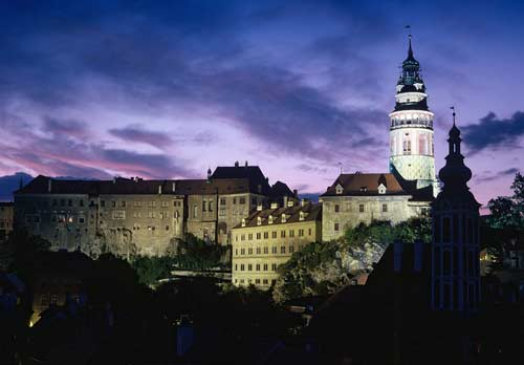
THE CASTLE OF Krummau in Bohemia stands majestically on its crag in a bend of the Moldau river, presiding confidently over the town below. Český Krumlov, as the town is known in the currently-reigning Czech language, began in the thirteenth century under the Rosenberg family and was purchased by the Emperor Rudolf II in 1602. Yet it was under the princely house of Schwarzenberg (proprietors of Krumau from 1719 to 1945) that the castle flourished. The name Český Krumlov means Bohemian Krummau, to differentiate it from a Moravian town of the same name. (It is also often rendered as Krumau or Krumau-an-der-Moldau).
While the advent of Communism deprived the Schwarzenbergs of this great castle and numerous other vast properties of theirs behind the Iron Curtain, the Schwarzenbergs have since regained their natural prominence in Bohemia. His Serene Highness Prince Karl VII of Schwarzenberg, Duke of Krummau, Count of Sulz, Princely Landgrave of Kelttgau currently serves his country as Minister of Foreign Affairs of the Czech Republic, as well as being a member of the Czech Senate which convenes in the Wallenstein Palace in Prague. For the sake of convenience, however, His Serene Highness goes by ‘Karel Schwarzenberg’. (more…)
St Andrews in London
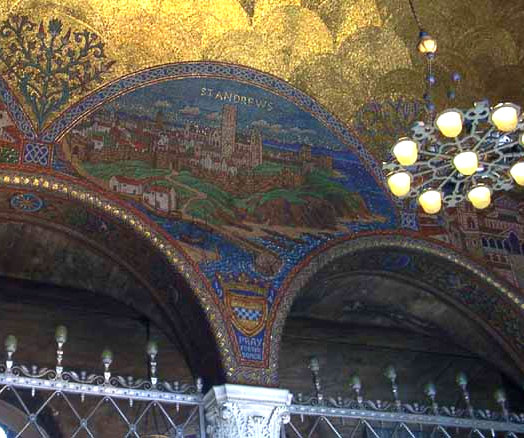
A LITTLE SOMETHING for our good friends from university who’ve just moved to London from the countryside. I hope that when they are in the Cathedral they will pop into our patron’s chapel, glance at the mosaic of our dear old Royal Burgh of St Andrews, remember good times, and say a prayer for us all.
Hipódromo Argentino de Palermo
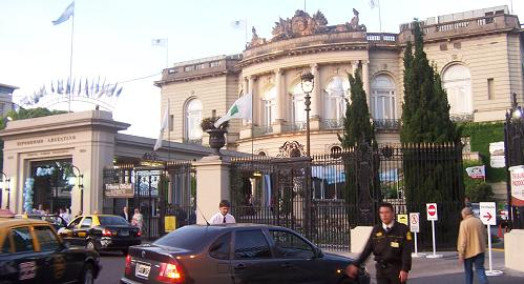
THE PALERMO RACETRACK is the main center for equestrian events in Buenos Aires. It was first built in 1876. In 1908 the current main stand was built to the beaux-arts design of a French architect, Louis Faure Dujarric. The Argentine Grand National, a race of 2,500 meters, has been run here annually since 1885. (more…)
Columbus Circle: A Wider View
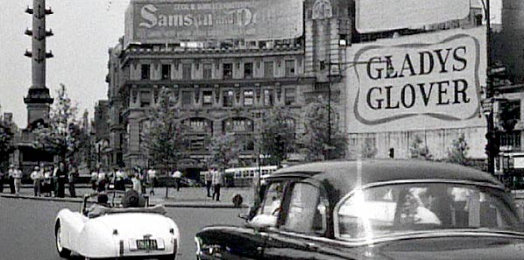
I THOUGHT THAT since we widened our window of opportunity, I ought to give you a wider view of this capture from the 1954 film ‘It Should Happen to You!’, previously displayed in our exposition on Columbus Circle and the Human Scale. The more recent rehabilitation of this grand public place was discussed in one of my diary entries. (more…)
Christopher Street, Greenwich Village
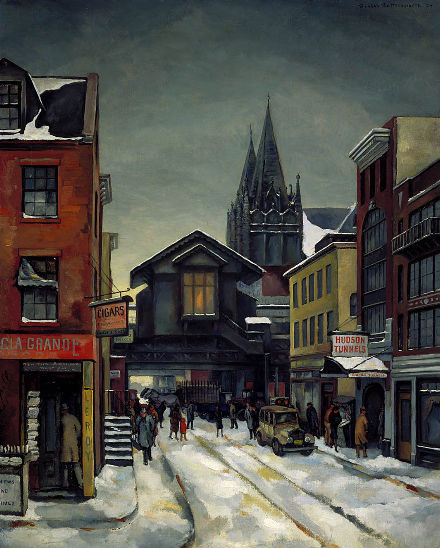
Beulah R. Bettersworth, Christopher Street, Greenwich Village
Oil on canvas, 30 1/8″ x 24 ¼”
1934, Smithsonian American Art Museum
The Old State House
Hartford, Connecticut
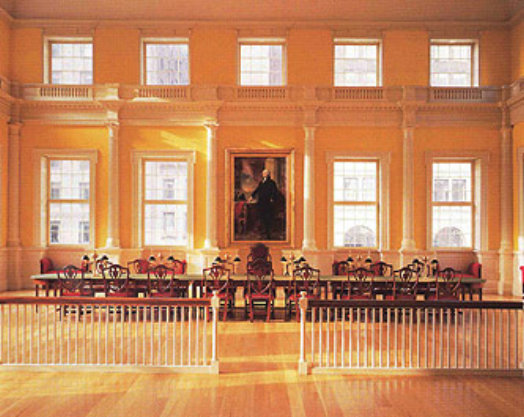
THE GREAT Russell Kirk once called the main chambers of the Old Connecticut State House “perhaps the most finely-proportioned rooms in all America”. The Senate of Connecticut met in the stately Senate Chamber (above) around a long table, as was the general fashion of the legislative councils which formed the upper house of most colonial legislatures. It was in the House of Representatives Chamber (below) that the famed Hartford Convention of December 1814 and January 1815 met and discussed New England’s possible secession from the Union. The State House was built in 1796 to the designs of Charles Bulfinch, on land which had been granted to Connecticut by King Charles II in 1662. (more…)
Grand Central Station at Night
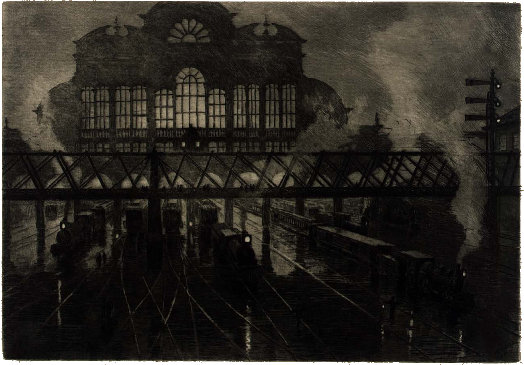
Charles Frederick William Mielatz, Grand Central Station at Night
Etching on paper, 7″ x 10″
1890, Smithsonian American Art Museum
This, of course, is not the Grand Central we know today, but its immediate predecessor.
Sinterklaasfeest

Wishing you all a very blessed Saint Nicholas day!
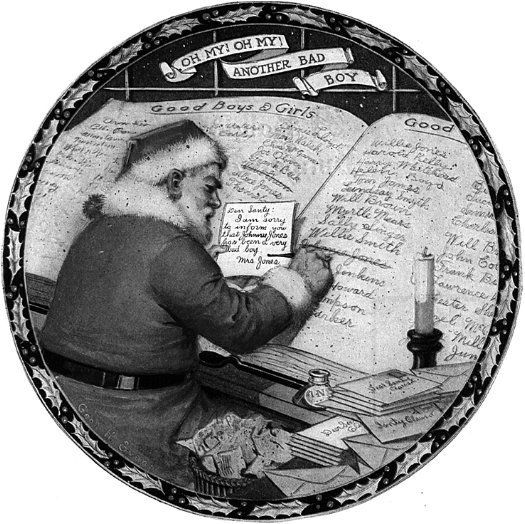
Sloppy Journalism at the National Catholic Register
Not long ago I signed up for a trial subscription to the National Catholic Register, and while it certainly exceeds the other national Catholic newspapers on presentation, it lacks the weight of the Wanderer. A quick glance in the October 28, 2007 edition makes this clear. I speak, namely, of the article “Knights Templar: More Than the Stuff of Fiction”. The article points out that the Order of the Knights Templar was “founded in Jerusalem in 1118 to protect Christian pilgrims and defend the Christian presence in the Holy Land. … It was suppressed by Pope Clement V in 1312, following accusation of heresy against its members, and subsequently became the focus of legends and mysteries, most recently the outrageously inaccurate Da Vinci Code by Dan Brown.” The article then mentioned the recent rediscovery in the Vatican Archives of a document relating to the Knights Templar. All fair enough, up to now.
The Register‘s correspondent “spoke last month in Rome with Patrick Rae, a former brigadier general in the U.S. Army Reserve who serves as Grand Commander of the Knights Templar.” Huh? What? Was it not just stated that the Knights Templar were suppressed by Pope Clement V in 1312? The Register offers no help in explaining this discrepancy to us. General Rae, however, later informs us that the Knights Templar “reconstituted as a French order under Napoleon and from that day until today it has existed, an unbroken string”. This is rather mixing fact and fiction.
1) The Knights Templar no longer exist. They were suppressed by the Pope in the fourteenth century and not revived.
2) The group of which Patrick Rae is Grand Commander is an organization called the “Ordo Supremus Militaris Templi Hierosolymitani” (OSMTH) also known by its English name of the “Sovereign Military Order of the Temple of Jerusalem” (SMOTJ). It is neither sovereign, nor is it an order, but is instead a Christian ecumenical aid organization which styles itself an order.
3) There are dozens, if not hundreds, of groups going around calling themselves the Order of Knights Templar. In actual fact, they are not orders (they are merely ordinary associations, like a chess club or your friendly local circle of stamp-collectors) and they are not Templar (since the Templars no longer exist).
It is beyond me why the Register‘s correspondent chose to speak with the head of this particular Templar-style group out of the hundreds of Templar-style groups. Perhaps the correspondent was impressed by the UN’s recognition of the OSMTH with special consultative status. This status has also been granted to many other groups, such as the Rotary Club of Kathmandu, the Tunisian Mothers Association, and the Boy Scouts of America. But the reporter makes no real attempt to point out that the Knights Templar in question are not, in fact, the Knights Templar (which, again, no longer exist). Whether he is disingenuous or merely ignorant is up to question (in a spirit of Christian charity, let us assume the latter). However there can be no question that this is simply sloppy journalism.
And for the man with $3,500 to spare…

Scoop, by Evelyn Waugh
Chapman & Hall, London, 1938
First edition, hardcover, very good condition.
Small octavo, 308 pages, dust jacket.
Bring Back the Broadsheet!
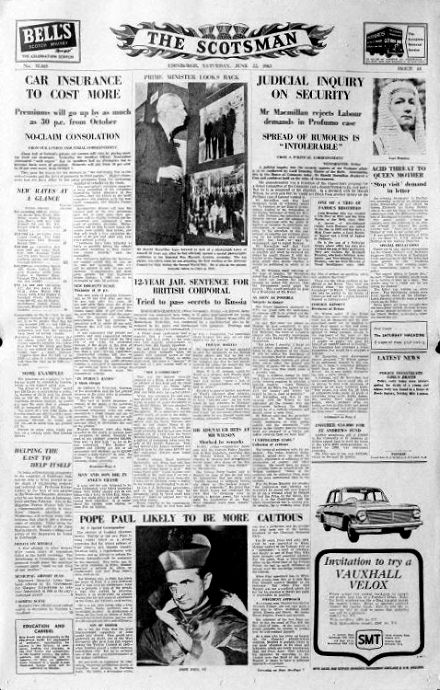
THE DECLINE OF Scotland’s nation newspaper is marked and lamentable. Once exhibiting a certain grace and dignity, the Scotsman was the most respected of Caledonian dailies. It was the only to have bureaus overseas, and it presided as king of the newspaper realm from stately offices on the heights of North Bridge. All of that, of course, is all gone. It’s all about cost-cutting and driving up circulation instead of maintaining the role as Scotland’s newspaper of record. (more…)
Irish Parliament House
Please see the updated article of the Irish Houses of Parliament, College Green, Dublin here.
Imperial Airways
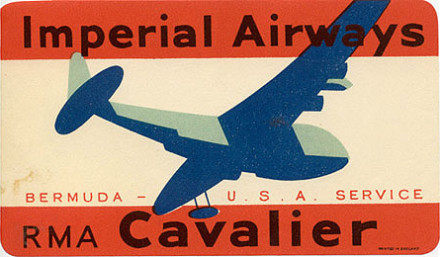
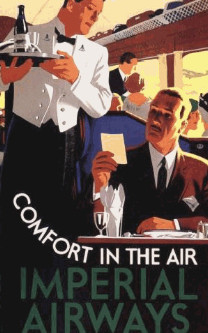




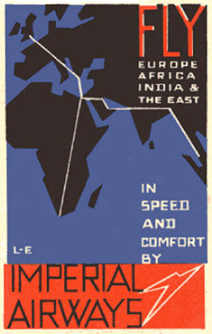


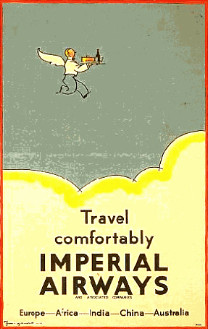

Previously: Bayerische Volkspartei | Lwow (Lvov/Lviv) | Empire State | Municipal Airports | Crêpes à Dentelles
Clarendon Court
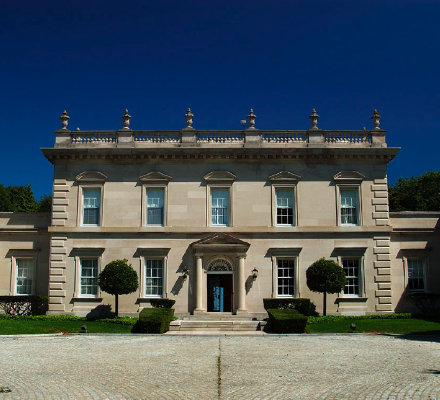
CLARENDON COURT IS one of the more comely of the Newport “cottages”. Built a little later than most, it avoids the Mediterranean gallimaufry of the Breakers and the French frilliness of many of the other Newport mansions (The Elms, Marble House, etc.). Its chief fame, however, comes not from its architectural excellence but rather as the family home where Sunny von Bülow fell into a permanent vegetative state, leading to the arrest and conviction for attempted murder of her husband Claus von Bülow. Von Bülow’s conviction was overturned on appeal, when he was represented by the famous Alan Dershowitz.
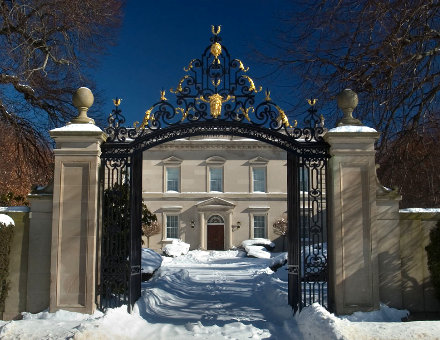

Previously: Salve Regina University
Insiginia of the Society of Colonial Wars
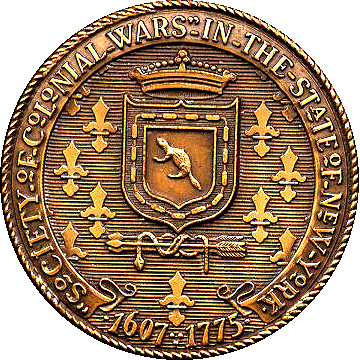
DEPRIVED OF THE hereditary principle by the lamentable break with Great Britain in 1783, Americans were eventually driven to inventing a hereditary social hierarchy, even more stringent than that of the mother country. Blood is the only qualification for membership of the numerous hereditary societies that dot the United States, unquestionably foremost among which is the Society of the Cincinnati. The Society of Colonial Wars, however, is one of the more prominent of the dozens of hereditary societies, and each state organization has devised its own seal or emblem. Below are exhibited a handful of examples.
The Church Resurgent
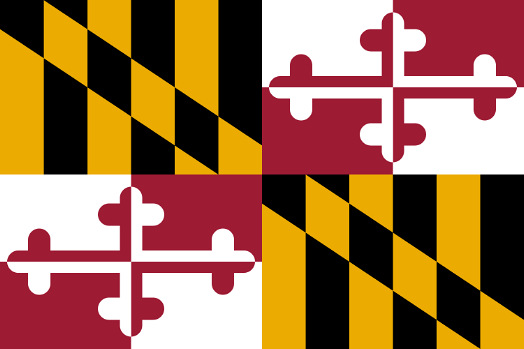
THE CATHOLIC COLONY of Maryland was first planted in 1634 at St. Mary’s, which became the first capital city of the Calvert family’s palatinate. The attempt to run Terra Mariae as a Catholic feudal state was continually frustrated by a number of fiery Protestant settlers, who eventually broke out into open rebellion in the 1650s while the Civil Wars raged back in England. Happily, Cecil Calvert, 2nd Baron Baltimore, sent out an army under Gov. William Stone to restore order to the colony, but was defeated by the Puritan force in March, 1655 at the Battle of the Severn. During the Puritans’ persecution of the Church, all the Catholic churches in Maryland were destroyed, and in 1667 a new ecclesiastical edifice was raised in St. Mary’s: the Brick Chapel.
The Rapalje Children
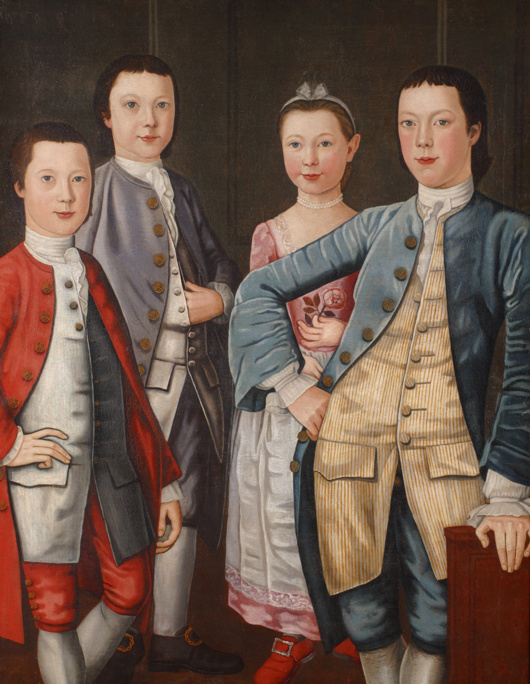
Oil on canvas, 50¾″ x 40″
1768, New-York Historical Society
Durand’s painting of the four children of this prominent mercantile family of Manhattan is one of the finest examples of group portraiture from the colonial period in America. From left to right are Garret (b. 1757), George (b. 1759), Anne (b. 1762), and Jacques (b. 1752).
The painter had come to New York from Virginia two years previous to paint individual portraits of the children of the Beekman family. Art historians suspect he was born or trained in France. Durand later returned to Virginia, where he continued to paint until his death in 1805.
Corpus Christi Church
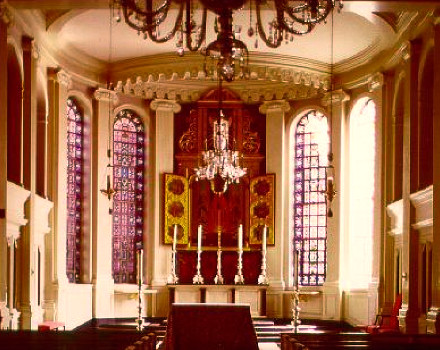
Corpus Christi Church, West 121st Street, New York: perhaps my favorite Catholic church interior in all New York, and one which simply cries out for a traditional Mass. (more…)
The Assay Office
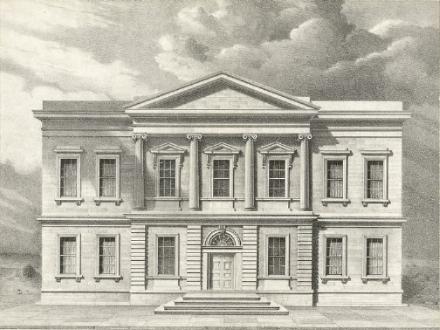
THE ASSAY OFFICE was built in 1822 as the New York branch of the Bank of the United States, located at 15½ Wall Street. The (Second) Bank of the United States was the second attempt at a central bank for this country. Eventually, the central bank grew too powerful, trying to manipulate politics and master the economy itself, and so it was abolished in 1836. The building later became the Assay Office, an adjunct to the Customs House and Sub-Treasury next door, which itself is now known as Federal Hall National Monument. When the Assay Office was torn down, the façade was preserved and donated to the Metropolitan Museum of Art by Robert W. de Forest in 1924. It is now presented in the glass-covered courtyard of the American Wing of the greatest museum of art in the New World. (more…)
Rip van Winkle
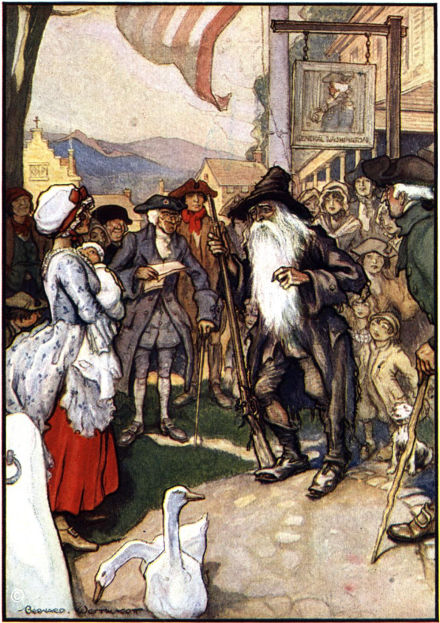
POOR RIP van Winkle; I always felt bad for him. He falls asleep for twenty years, and returns to his own native village where is now unknown and taken for some strange vagrant. “I am a poor quiet man, a native of the place, and a loyal subject of the king, God bless him!” he exclaims, in blissful ignorance of the Revolution which took place during his slumber. “A tory! a tory! a spy! a refugee! hustle him! away with him!” cry the by-standers.
I have long thought that Washington Irving was trying to make a subtle traditionalist point here: the definition of a good citizen has been arbitrarily changed. If a man was a good New Yorker in 1765 and hasn’t changed, why is he a traitor in 1785? It’s clearly ridiculous, except to proto-Jacobins and ideologues.
Anyhow, the lesson of the story: drink not from the flagons of odd-looking personages playing nine-pins amidst the Hudson Highlands.
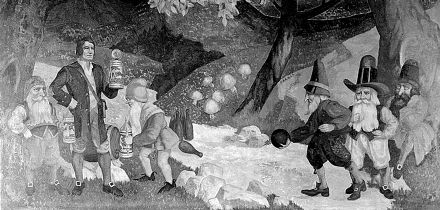
Previously: Rip van Winkle
Search
Instagram: @andcusack
Click here for my Instagram photos.Most Recent Posts
- Amsterdam November 26, 2024
- Silver Jubilee November 21, 2024
- Articles of Note: 11 November 2024 November 11, 2024
- Why do you read? November 5, 2024
- India November 4, 2024
Most Recent Comments
- on The Catholic Apostolic Church, Edinburgh
- on Articles of Note: 11 November 2024
- on Articles of Note: 11 November 2024
- on Why do you read?
- on Why do you read?
- on University Nicknames in South Africa
- on The Situation at St Andrews
- on An Aldermanian Skyscraper
- on Equality
- on Rough Notes of Kinderhook
Book Wishlist
Monthly Archives
Categories


